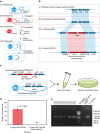Dissemination of antibiotic resistance genes from antibiotic producers to pathogens
- PMID: 28589945
- PMCID: PMC5467266
- DOI: 10.1038/ncomms15784
Dissemination of antibiotic resistance genes from antibiotic producers to pathogens
Abstract
It has been hypothesized that some antibiotic resistance genes (ARGs) found in pathogenic bacteria derive from antibiotic-producing actinobacteria. Here we provide bioinformatic and experimental evidence supporting this hypothesis. We identify genes in proteobacteria, including some pathogens, that appear to be closely related to actinobacterial ARGs known to confer resistance against clinically important antibiotics. Furthermore, we identify two potential examples of recent horizontal transfer of actinobacterial ARGs to proteobacterial pathogens. Based on this bioinformatic evidence, we propose and experimentally test a 'carry-back' mechanism for the transfer, involving conjugative transfer of a carrier sequence from proteobacteria to actinobacteria, recombination of the carrier sequence with the actinobacterial ARG, followed by natural transformation of proteobacteria with the carrier-sandwiched ARG. Our results support the existence of ancient and, possibly, recent transfers of ARGs from antibiotic-producing actinobacteria to proteobacteria, and provide evidence for a defined mechanism.
Conflict of interest statement
The authors declare no competing financial interests.
Figures



References
-
- Wright G. D. The antibiotic resistome: the nexus of chemical and genetic diversity. Nat. Rev. Microbiol. 5, 175–186 (2007). - PubMed
-
- Thaker M. N. et al. Identifying producers of antibacterial compounds by screening for antibiotic resistance. Nat. Biotechnol. 31, 922–927 (2013). - PubMed
-
- Forsman M., Häggström B., Lindgren L. & Jaurin B. Molecular analysis of β-lactamases from four species of Streptomyces: comparison of amino acid sequences with those of other β-clactamases. Microbiology 136, 589–598 (1990). - PubMed
Publication types
MeSH terms
Substances
LinkOut - more resources
Full Text Sources
Other Literature Sources
Medical
Molecular Biology Databases

